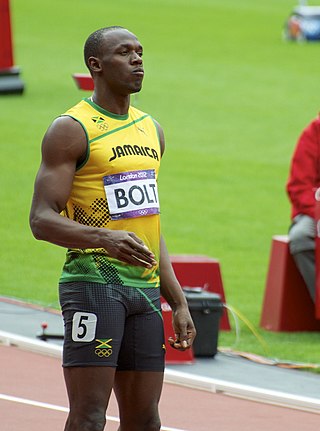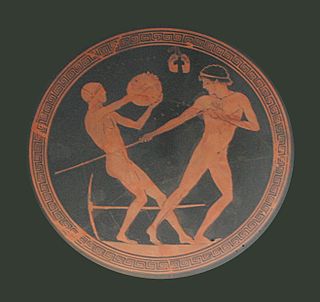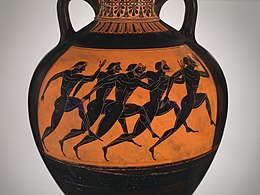
Running is a method of terrestrial locomotion by which humans and other animals move rapidly on foot. Running is a gait with an aerial phase in which all feet are above the ground. This is in contrast to walking, where one foot is always in contact with the ground, the legs are kept mostly straight, and the center of gravity vaults over the stance leg or legs in an inverted pendulum fashion. A feature of a running body from the viewpoint of spring-mass mechanics is that changes in kinetic and potential energy within a stride co-occur, with energy storage accomplished by springy tendons and passive muscle elasticity. The term "running" can refer to a variety of speeds ranging from jogging to sprinting.
A triatlon is an endurance multisport race consisting of swimming, cycling, and running over various distances. Triathletes compete for fastest overall completion time, racing each segment sequentially with the time transitioning between the disciplines included. The word is of Greek origin, from τρεῖς or treis (three) and ἆθλος or athlos (competition).

Athletics is a group of sporting events that involves competitive running, jumping, throwing, and walking. The most common types of athletics competitions are track and field, road running, cross-country running, and racewalking.

The 1896 Summer Olympics, officially known as the Games of the I Olympiad and commonly known as Athens 1896, was the first international Olympic Games held in modern history. Organised by the International Olympic Committee (IOC), which had been created by French aristocrat Pierre de Coubertin, it was held in Athens, Greece, from 6 to 15 April 1896.

The marathon is a long-distance foot race with a distance of 42.195 km, usually run as a road race, but the distance can be covered on trail routes. The marathon can be completed by running or with a run/walk strategy. There are also wheelchair divisions. More than 800 marathons are held throughout the world each year, with the vast majority of competitors being recreational athletes, as larger marathons can have tens of thousands of participants.

At the 1896 Summer Olympics, the first modern Olympiad, twelve athletics events were contested. A total of 25 medals were awarded. The medals were later denoted as 37 modern medals. All of the events except the marathon were held in the Panathinaiko Stadium, which was also the finish for the marathon. Events were held on 6 April, 7 April, 9 April, and 10 April 1896. Altogether, 63 athletes, all men, from nine nations competed. This made athletics the most international of the nine sports at the 1896 Games.

Sprinting is running over a short distance at the top-most speed of the body in a limited period of time. It is used in many sports that incorporate running, typically as a way of quickly reaching a target or goal, or avoiding or catching an opponent. Human physiology dictates that a runner's near-top speed cannot be maintained for more than 30–35 seconds due to the depletion of phosphocreatine stores in muscles, and perhaps secondarily to excessive metabolic acidosis as a result of anaerobic glycolysis.

Long-distance running, or endurance running, is a form of continuous running over distances of at least 3 km (1.9 mi). Physiologically, it is largely aerobic in nature and requires stamina as well as mental strength.

Track and field is a sport that includes athletic contests based on running, jumping, and throwing skills. The name is derived from where the sport takes place, a running track and a grass field for the throwing and some of the jumping events. Track and field is categorized under the umbrella sport of athletics, which also includes road running, cross country running and racewalking. In British English the term "Athletics" is synonymous with American "Track and Field" and includes all jumping events.

A pentathlon is a contest featuring five events. The name is derived from Greek: combining the words pente (five) and -athlon (competition). The first pentathlon was documented in Ancient Greece and was part of the Ancient Olympic Games. Five events were contested over one day for the Ancient Olympic pentathlon, starting with the long jump, javelin throwing, and discus throwing, followed by the stadion and wrestling. Pentathletes were considered to be among the most skilled athletes, and their training was often part of military service—each of the five events in the pentathlon was thought to be useful in war or battle.

The gymnasium in Ancient Greece functioned as a training facility for competitors in public games. It was also a place for socializing and engaging in intellectual pursuits. The name comes from the Ancient Greek term gymnós, meaning "naked" or "nude". Only adult male citizens were allowed to use the gymnasia.
Jack Tupper Daniels is an American exercise physiologist, running coach and a coach of Olympic athletes. On March 21, 2013, he was named the head coach of the Wells College men's and women's cross country programs. He received his doctoral degree in exercise physiology at the University of Wisconsin–Madison. Named "The World's Best Coach" by Runner's World magazine, he led SUNY Cortland runners to eight NCAA Division III National Championships, 31 individual national titles, and more than 130 All-America awards. Daniels outlined his training philosophies in the 1998 book, Daniels' Running Formula. He mentors and coaches some of America's top distance runners in the country.

Physical fitness is a state of health and well-being and, more specifically, the ability to perform aspects of sports, occupations, and daily activities. Physical fitness is generally achieved through proper nutrition, moderate-vigorous physical exercise, and sufficient rest along with a formal recovery plan.
Fartlek is a middle and long-distance runner's training approach developed in the late 1930s by Swedish Olympian Gösta Holmér. It has been described as a relatively unscientific blending of continuous training, with its steady pace of moderate-high intensity aerobic intensity, and interval training, with its "spacing of more intense exercise and rest intervals". Simply stated, in its widely adapted contemporary forms, fartlek training is alternating periods of faster and slower running, often over natural terrain, including both "level and hilly terrain".

Altitude training is the practice by some endurance athletes of training for several weeks at high altitude, preferably over 2,400 metres (8,000 ft) above sea level, though more commonly at intermediate altitudes due to the shortage of suitable high-altitude locations. At intermediate altitudes, the air still contains approximately 20.9% oxygen, but the barometric pressure and thus the partial pressure of oxygen is reduced.

Halteres were a type of dumbbells used in Ancient Greece. In Ancient Greek sports, halteres were used as lifting weights, and also as weights in their version of the long jump. Halteres were held in both hands to allow an athlete to jump a greater distance; they may have been dropped after the first or second jump.

CrossFit is a branded fitness regimen that involves constantly varied functional movements performed at high intensity. The method was developed by Greg Glassman, who founded CrossFit with Lauren Jenai in 2000, with CrossFit its registered trademark. The company forms what has been described as the biggest fitness chain in the world, with around 12,000 affiliated gyms in over 150 countries as of 2022, under half of which are located in the United States.

The Ancient Olympic pentathlon was an athletic contest at the Ancient Olympic Games, and other Panhellenic Games of Ancient Greece. The name derives from Greek, combining the words pente (five) and athlon (competition). Five events were contested over one day, starting with the stadion, followed by the javelin throw, discus throw and long jump, and ending with wrestling. While pentathletes were considered to be inferior to the specialized athletes in a certain event, they were superior in overall development and were some of the most well balanced of all the athletes. Their training was often part of military service—each of the five events was thought to be useful in battle.
Athletics is a term encompassing the human competitive sports and games requiring physical skill, and the systems of training that prepare athletes for competitive performance. Athletic sports or contests are competitions which are primarily based on human physical competition, demanding the qualities of stamina, fitness, and skill. Athletic sports form the bulk of popular sporting activities, with other major forms including motorsports, precision sports, extreme sports and animal sports.

Physical training has been present in human societies throughout history. Usually, it was performed for the purposes of preparing for physical competition or display, improving physical, emotional and mental health, and looking attractive. It took a variety of different forms but quick dynamic exercises were favoured over slow or more static ones. For example, running, jumping, wrestling, gymnastics and throwing heavy stones are mentioned frequently in historical sources and emphasised as being highly effective training methods. Notably, they are also forms of exercise which are readily achievable for most people to some extent or another.




















